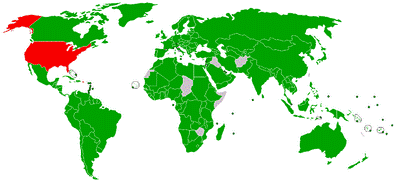Kyoto Protocol


Introduction
The Kyoto Protocol is a protocol to the United Nations Framework Convention on Climate Change (UNFCCC or FCCC), an international environmental treaty produced at the United Nations Conference on treaty is intended to achieve "stabilization of greenhouse gas concentrations in the atmosphere at a level that would prevent dangerous anthropogenic interference with the climate system."[1] The Kyoto Protocol establishes legally binding commitments for the reduction of four greenhouse gases (carbon dioxide, methane, nitrous oxide, sulphur hexafluoride), and two groups of gases (hydrofluorocarbons and perfluorocarbons) produced by "Annex I" (industrialized) nations, as well as general commitments for all member countries. As of 2008, 183 parties have ratified the protocol,[2] which was initially adopted for use on 11 December 1997 in Kyoto, Japan and which entered into force on 16 February 2005. Under Kyoto, industrialized countries agreed to reduce their collective GHG emissions by 5.2% compared to the year 1990. National limitations range from 8% reductions for the European Union and some others to 7% for the United States, 6% for Japan, and 0% for Russia. The treaty permitted GHG emission increases of 8% for Australia and 10% for Iceland.[3]
Kyoto includes defined "flexible mechanisms" such as Emissions Trading, the Clean Development Mechanism and Joint Implementation to allow Annex I economies to meet their greenhouse gas (GHG) emission limitations by purchasing GHG emission reductions credits from elsewhere, through financial exchanges, projects that reduce emissions in non-Annex I economies, from other Annex I countries, or from Annex I countries with excess allowances. In practice this means that Non-Annex I economies have no GHG emission restrictions, but have financial incentives to develop GHG emission reduction projects to receive "carbon credits" that can then be sold to Annex I buyers, encouraging sustainable development.[4] In addition, the flexible mechanisms allow Annex I nations with efficient, low GHG-emitting industries, and high prevailing environmental standards to purchase carbon credits on the world market instead of reducing greenhouse gas emissions domestically. Annex I entities typically will want to acquire carbon credits as cheaply as possible, while Non-Annex I entities want to maximize the value of carbon credits generated from their domestic Greenhouse Gas Projects.
Among the Annex I signatories, all nations have established Designated National Authorities to manage their greenhouse gas portfolios; countries including Japan, Canada, Italy, the Netherlands, Germany, France, Spain and others are actively promoting government carbon funds, supporting multilateral carbon funds intent on purchasing Carbon Credits from Non-Annex I countries,[citation needed] and are working closely with their major utility, energy, oil & gas and chemicals conglomerates to acquire Greenhouse Gas Certificates as cheaply as possible.[citation needed] Virtually all of the non-Annex I countries have also established Designated National Authorities to manage the Kyoto process, specifically the "CDM process" that determines which GHG Projects they wish to propose for accreditation by the CDM Executive Board.
Objectives
The objective is the "stabilization of greenhouse gas concentrations in the atmosphere at a level that would prevent dangerous anthropogenic interference with the climate system. The Intergovernmental Panel on Climate Change (IPCC) has predicted an average global rise in temperature of 1.4°C (2.5°F) to 5.8°C (10.4°F) between 1990 and 2100.
Proponents also note that Kyoto is a first step as requirements to meet the UNFCCC will be modified until the objective is met, as required by UNFCCC Article 4.2(d).
The treaty was negotiated in Kyoto, Japan in December 1997, opened for signature on 16 March 1998, and closed on 15 March 1999. The agreement came into force on 16 February 2005 following ratification by Russia on 18 November 2004. As of May 2008, a total of 181 countries and 1 regional economic integration organization (the EC) have ratified the agreement (representing over 61.6% of emissions from Annex I countries).
According to article 25 of the protocol, it enters into force "on the ninetieth day after the date on which not less than 55 Parties to the Convention, incorporating Parties included in Annex I which accounted in total for at least 55% of the total carbon dioxide emissions for 1990 of the Parties included in Annex I, have deposited their instruments of ratification, acceptance, approval or accession." Of the two conditions, the "55 parties" clause was reached on 23 May 2002 when Iceland ratified. The ratification by Russia on 18 November 2004 satisfied the "55%" clause and brought the treaty into force, effective 16 February 2005. Australian Prime Minister Kevin Rudd ratified the Kyoto protocol on 3 December 2007. This came into effect after 90 days (the end of March 2008), as is stated in the guidelines set by the United Nations.
The five principle concepts of the Kyoto Protocol are:
- Commitments : The heart of the Protocol lies in establishing commitments for the reduction of greenhouse gases that are legally binding for Annex I countries, as well as general commitments for all member countries.
- Implementation : In order to meet the objectives of the Protocol, Annex I countries are required to prepare policies and measures for the reduction of greenhouse gases in their respective countries. In addition, they are required to increase the absorption of these gases and utilize all mechanisms available, such as joint implementation, the clean development mechanism and emissions trading, in order to be rewarded with credits that would allow more greenhouse gas emissions at home.
- Minimizing Impacts on Developing Countries by establishing an adaptation fund for climate change.
- Accounting, Reporting and Review in order to ensure the integrity of the Protocol.
- Compliance : Establishing a Compliance Committee to enforce compliance with the commitments under the Protocol.
|

